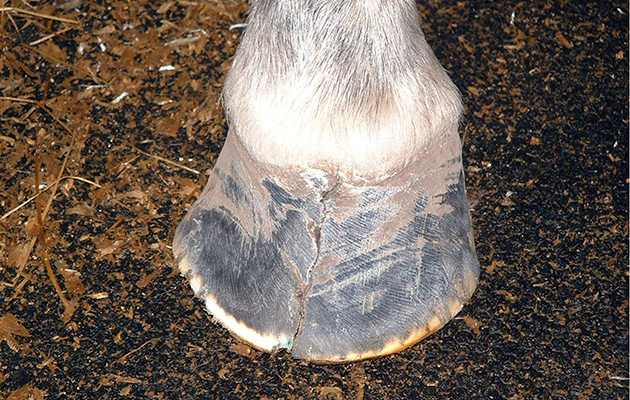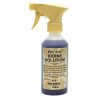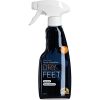Thrush in horses is an unpleasant infection of the central and collateral grooves of the frog.
Keratonolytic (keratin-dissolving) bacteria, including the sheep foot rot organism Fusobacterium necrophorum, attack the softened tissues of the frog, causing it to rot away.
Thrush in horses [722 words]: Signs | Causes | Treatment | Other conditions
Signs of thrush
The most obvious sign of thrush is a foul-smelling, black discharge from the frog, which itself may have softer spots and appear irregular in shape. Despite the offensive smell and discharge, many horses with thrush show no obvious discomfort or lameness.
If the infection is severe it can spread to involve the deeper structures in the hoof, such as the digital cushion, hoof wall and heel bulb, resulting in disintegrating horn. Then there may be some pain around the frog and bulbs of the heel, together with filling of the limbs and lameness of varying degrees only when sensitive tissues involved.
What causes thrush in horses?
Unhygienic environmental conditions: Stabling for prolonged periods on soiled, sodden bedding; or turnout on constantly damp, swampy or marshy pasture. The damp conditions of a dirty stable provide the perfect environment for the anaerobic bacteria, (those needing a low-oxygen environment) which cause thrush to flourish.
Poor foot conformation (especially of the frog): Long narrow feet, prone to contracted heels, with associated small, narrow frog and a compressed deep central groove; sheared heels, where a gap develops between the bulbs of the heels due to a chronic foot imbalance; an acquired frog deformity, perhaps as the result of an injury. A deep cleft in the frog may become packed with sand after working in an arena. If not carefully cleaned, this could lead to irritation and allow bacteria to enter.
Poor or incorrect foot trimming/shoeing: A badly fitting frog plate of a heart-bar shoe can damage the frog, leading to a secondary infection; a badly shaped shoe, nailed too far back, can prevent expansion and contraction of the heels, leading to shrinkage and possible “rotting away” of the frog; shoeing with full pads, allowing dirt and moisture to collect and fester.
Poor foot care: Not regularly picking out and cleaning the feet
Traditionally, thrush has been considered a product of bad stable management. This is definitely not always the case. Some horses kept in foul underfoot conditions are unaffected, while others in perfect accommodation are. The individual susceptibility of the horse seems to be a major factor.
Treatment of thrush in horses
If a horse has thrush the underlying cause needs to be identified and removed. The horse should be moved to a clean, dry environment and the feet cleaned daily.
Treatment may need to be carried out by a vet or farrier and can be very time consuming. All dead and/or damaged tissue needs to be pared away on at least one occasion until healthy tissue is reached. After paring, topical treatment with an astringent medication such as 10% formalin, chlorine bleach, phenol or providone iodine follows. An antibiotic solution or spray should then be applied and if the trimming has been extensive, bandaging may be necessary.
The hoof and its environment should be kept as dry and clean as possible. Keep stables clean with plenty of good quality, dry bedding.
Paper or a shaving bed may be preferable and if the horse is turned out it should only be on a well draining paddock or it should be brought in to stand in the dry for several hours each day. If horses are in for long periods, bank the beds during the day to allow them to stand on a clean, dry surface.
Antibiotics treatment usually makes very little difference and are usually unnecessary. Ensure the feet are properly trimmed and shod, especially if there are any contributory foot issues. It is also vital to ensure the feet are properly and frequently picked out.
Thrush will never resolve unless the hoof hygiene is good. A damaged frog is the perfect entry point for the bacteria that cause tetanus, so ensure that the horse has adequate protection against this.
Conditions than can be confused with thrush
Wounds – Sometimes the frog is sliced or punctured by flints or other sharp objects. These cuts can become infected if they’re deep, causing lameness.
Canker – This is a more serious condition, where the horse is lame and the frog becomes really soft, smelly and stringy. Canker can spread to the sole and is hard to treat, often requiring surgery and aggressive resection of diseased tissue, which can cause further lameness. It is particularly common in heavy horses, more so in the hind feet. It can be very challenging to resolve.
You might also like:

Equine ringworm: what all horse owners need to know

Hoof cracks – when should horse owners be concerned?

Struggling with mud fever? Here’s what you need to know to tackle it…

Subscribe to Horse & Hound magazine today – and enjoy unlimited website access all year round
Horse & Hound magazine, out every Thursday, is packed with all the latest news and reports, as well as interviews, specials, nostalgia, vet and training advice. Find how you can enjoy the magazine delivered to your door every week, plus options to upgrade your subscription to access our online service that brings you breaking news and reports as well as other benefits.




